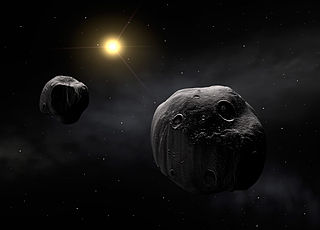(90) Antíope
| (90) Antíope | ||||||
|---|---|---|---|---|---|---|
 | ||||||
| Descubrimiento | ||||||
| Descubridor | Robert Luther | |||||
| Fecha | 1 de octubre de 1866 | |||||
| Lugar | Düsseldorf | |||||
| Designaciones | 1952 BK2 | |||||
| Categoría | Cinturón de asteroides - Temis | |||||
| Orbita a | Sol | |||||
| Elementos orbitales | ||||||
| Longitud del nodo ascendente | 69,99° | |||||
| Inclinación | 2,207° | |||||
| Argumento del periastro | 244,6° | |||||
| Semieje mayor | 3,151 ua | |||||
| Excentricidad | 0,1646 | |||||
| Anomalía media | 223,3° | |||||
| Elementos orbitales derivados | ||||||
| Época | 2457000.5 (2014-Dec-09.0) TDB[1] | |||||
| Periastro o perihelio | 2,632 ua | |||||
| Apoastro o afelio | 3,67 ua | |||||
| Período orbital sideral | 2043 días | |||||
| Velocidad orbital media | 0,18 grados/día | |||||
| Características físicas | ||||||
| Masa | 830 petagramos | |||||
| Diámetro | 120,1 km | |||||
| Periodo de rotación | 16,51 horas | |||||
| Clase espectral |
| |||||
| Magnitud absoluta | 8.47 | |||||
| Albedo | 0,0603 | |||||
| Cuerpo celeste | ||||||
| Anterior | (89) Julia | |||||
| Siguiente | (91) Egina | |||||
(90) Antíope es un asteroide perteneciente al cinturón de asteroides descubierto por Karl Theodor Robert Luther desde el observatorio de Düsseldorf-Bilk, Alemania, el 1 de octubre de 1866. Se denominó Antíope en referencia al personaje de la mitología griega.[2]
Características orbitales
[editar]Antíope está situado a una distancia media de 3,151 ua del Sol, pudiendo alejarse hasta 3,67 ua. Su excentricidad es 0,1646 y la inclinación orbital 2,207°. Emplea en completar una órbita alrededor del Sol 2043 días. Forma parte de la familia asteroidal de Temis.[3]
Véase también
[editar]Referencias
[editar]- ↑ «Datos de la NASA (JPL Small-Body Database Browser)». Consultado el 22 de junio de 2015.
- ↑ Schmadel, Lutz D. (2003). Dictionary of Minor Planet Names (en inglés) (5ª edición). Springer. ISBN 3-540-00238-3.
- ↑ Hirayama, Kiyotsugu (1918). «Group of asteroids probably of common origin». The Astronomical Journal (en inglés) (743). Consultado el 29 de julio de 2015.
Enlaces externos
[editar]- «(90) Antiope» (en inglés). Minor Planet Center. Consultado el 21 de junio de 2015.
Text is available under the CC BY-SA 4.0 license; additional terms may apply.
Images, videos and audio are available under their respective licenses.
